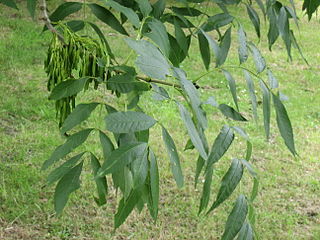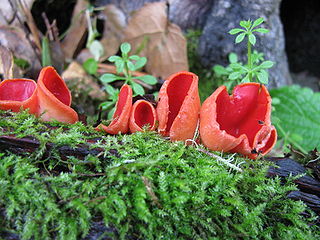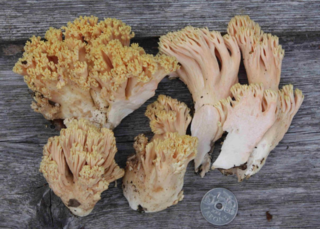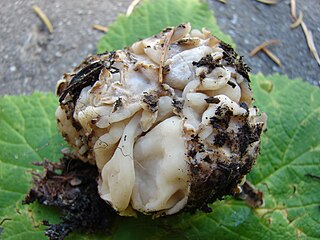
Fraxinus excelsior, known as the ash, or European ash or common ash to distinguish it from other types of ash, is a flowering plant species in the olive family Oleaceae. It is native throughout mainland Europe east to the Caucasus and Alborz mountains, and Great Britain and Ireland, the latter determining its western boundary. The northernmost location is in the Trondheimsfjord region of Norway. The species is widely cultivated and reportedly naturalised in New Zealand and in scattered locales in the United States and Canada.

A truffle is the fruiting body of a subterranean ascomycete fungus, one of the species of the genus Tuber. More than one hundred other genera of fungi are classified as truffles including Geopora, Peziza, Choiromyces, and Leucangium. These genera belong to the class Pezizomycetes and the Pezizales order. Several truffle-like basidiomycetes are excluded from Pezizales, including Rhizopogon and Glomus. Truffles are ectomycorrhizal fungi, so they are found in close association with tree roots. Spore dispersal is accomplished through fungivores, animals that eat fungi. These fungi have ecological roles in nutrient cycling and drought tolerance.

Amanita fulva, commonly called the tawny grisette or the orange-brown ringless amanita, is a basidiomycete mushroom of the genus Amanita. It is found frequently in deciduous and coniferous forests of Europe, and possibly North America.

Lactarius deterrimus, also known as false saffron milkcap or orange milkcap, is a species of fungus in the family Russulaceae. The fungus produces medium-sized fruit bodies (mushrooms) with orangish caps up to 12 centimetres wide that develop green spots in old age or if injured. Its orange-coloured latex stains maroon within 30 minutes. Lactarius deterrimus is a mycorrhizal fungus that associates with Norway spruce and bearberry. The species is distributed in Europe, but has also found in parts of Asia. A visually similar species in the United States and Mexico is not closely related to the European species. Fruit bodies appear between late June and November, usually in spruce forests. Although the fungus is edible—like all Lactarius mushrooms from the section Deliciosi—its taste is often bitter, and it is not highly valued. The fruit bodies are used as source of food for the larvae of several insect species. Lactarius deterrimus can be distinguished from similar Lactarius species by difference in the mycorrhizal host or latex colour.

Hydnum repandum, commonly known as the sweet tooth, pig's trotter, wood hedgehog or hedgehog mushroom, is a basidiomycete fungus of the family Hydnaceae. First described by Carl Linnaeus in 1753, it is the type species of the genus Hydnum. The fungus produces fruit bodies (mushrooms) that are characterized by their spore-bearing structures—in the form of spines rather than gills—which hang down from the underside of the cap. The cap is dry, colored yellow to light orange to brown, and often develops an irregular shape, especially when it has grown closely crowded with adjacent fruit bodies. The mushroom tissue is white with a pleasant odor and a spicy or bitter taste. All parts of the mushroom stain orange with age or when bruised.

Suillus luteus is a bolete fungus, and the type species of the genus Suillus. A common fungus native all across Eurasia from Ireland to Korea, it has been introduced widely elsewhere, including North and South America, southern Africa, Australia and New Zealand. Commonly referred to as slippery jack or sticky bun in English-speaking countries, its names refer to the brown cap, which is characteristically slimy in wet conditions. The fungus, initially described as Boletus luteus by Carl Linnaeus in 1753, is now classified in a different fungus family as well as genus. Suillus luteus is edible, though not as highly regarded as other bolete mushrooms. It is commonly prepared and eaten in soups, stews or fried dishes. The slime coating, however, may cause indigestion if not removed before eating. It is often sold as a dried mushroom.

Heterobasidion annosum is a basidiomycete fungus in the family Bondarzewiaceae. It is considered to be the most economically important forest pathogen in the Northern Hemisphere. Heterobasidion annosum is widespread in forests in the United States and is responsible for the loss of one billion U.S. dollars annually. This fungus has been known by many different names. First described by Fries in 1821, it was known by the name Polyporus annosum. Later, it was found to be linked to conifer disease by Robert Hartig in 1874, and was renamed Fomes annosus by H. Karsten. Its current name of Heterobasidion annosum was given by Brefeld in 1888. Heterobasidion annosum causes one of the most destructive diseases of conifers. The disease caused by the fungus is named annosus root rot.

Sarcoscypha coccinea, commonly known as the scarlet elf cup, or the scarlet cup, is a species of fungus in the family Sarcoscyphaceae of the order Pezizales. The fungus, widely distributed in the Northern Hemisphere, has been found in Africa, Asia, Europe, North and South America, and Australia. The type species of the genus Sarcoscypha, S. coccinea has been known by many names since its first appearance in the scientific literature in 1772. Phylogenetic analysis shows the species to be most closely related to other Sarcoscypha species that contain numerous small oil droplets in their spores, such as the North Atlantic island species S. macaronesica. Due to similar physical appearances and sometimes overlapping distributions, S. coccinea has often been confused with S. occidentalis, S. austriaca, and S. dudleyi.

Ramaria formosa, commonly known as the pinkish coral mushroom, salmon coral, beautiful clavaria, handsome clavaria, yellow-tipped- or pink coral fungus, is a coral fungus found in Europe. Similar forms collected in North America are considered to represent a different species.

Sarcodon imbricatus, commonly known as the shingled hedgehog or scaly hedgehog, is a species of tooth fungus in the order Thelephorales. The mushroom is edible. Many sources report it has a bitter taste, but others have found it delicious and suspect that the bitter specimens may be similar related species. The mushroom has a large, brownish cap with large brown scales and may reach 30 cm (12 in) in diameter. On the underside it sports greyish, brittle teeth instead of gills, and has white flesh. Its spore print is brown. It is associated with spruce (Picea), appearing in autumn. It ranges throughout North America and Europe, although collections from the British Isles are now assigned to the similar species Sarcodon squamosus.

Amanita excelsa var. spissa is a variety of basidiomycete fungus of the genus Amanita. This large, grey to brown-capped fungus has a very variable appearance but is commonly encountered in coniferous and deciduous forests in Europe and North America. It is sometimes referred to by the common name grey spotted Amanita.

Mutinus caninus, commonly known as the dog stinkhorn, is a small thin, phallus-shaped woodland fungus, with a dark tip. It is often found growing in small groups on wood debris, or in leaf litter, during summer and autumn in Europe, Asia, and eastern North America. It is not generally considered edible, although there are reports of the immature 'eggs' being consumed.

Geopora is a genus of truffle-like fungi in the family Pyronemataceae, currently with 13 described species. The genus was circumscribed by mycologist Harvey Willson Harkness in 1885. Molecular phylogenetic reconstructions indicate that the cup-like apothecial Geopora should better be placed back in a separate genus, Sepultaria. Geopora would then only comprise Geopora cooperi and its close relatives.

Sarcosphaera is a fungal genus within the Pezizaceae family. It is a monotypic genus, containing the single species Sarcosphaera coronaria, commonly known as the pink crown, the violet crown-cup, or the violet star cup. Although several taxa have been described as Sarcosphaera species since the introduction of the genus in 1869, most lack modern descriptions, have been transferred to the related genus Peziza, or are considered synonymous with S. coronaria.

Geopora cooperi, commonly known as the pine truffle or the fuzzy truffle, is a species of fungus in the family Pyronemataceae. It has a fuzzy brown outer surface and an inner surface of whitish, convoluted folds of tissue. Widely distributed in the Northern Hemisphere, the species has been recorded from Asia, Europe, and North America.

Hydnellum ferrugineum, commonly known as the mealy tooth or the reddish-brown corky spine fungus, is a species of tooth fungus in the family Bankeraceae. A widely distributed species, it is found in north Africa, Asia, Europe, and North America. The fungus fruits on the ground singly or in clusters in conifer forest, usually in poor or sandy soil. Fruit bodies are somewhat top-shaped, measuring 3–10 cm (1–4 in) in diameter. Their velvety surfaces, initially white to pink, sometimes exude drops of red liquid. The lower surface of the fruit body features white to reddish-brown spines up to 6 mm long. Mature fruit bodies become dark reddish brown in color, and are then difficult to distinguish from other similar Hydnellum species. H. ferrugineum forms a mat of mycelia in the humus and upper soil where it grows. The presence of the fungus changes the characteristics of the soil, making it more podzolized.

Suillus collinitus is a pored mushroom of the genus Suillus in the family Suillaceae. It is an edible mushroom found in European pine forests. The mushroom has a reddish to chestnut-brown cap that reaches up to 11 cm (4.3 in) in diameter, and a yellow stem measuring up to 7 cm (2.8 in) tall by 1 to 2 cm thick. On the underside of the cap are small angular pores, initially bright yellow before turning greenish-brown with age. A characteristic feature that helps to distinguish it from similar Suillus species, such as S. granulatus, is the pinkish mycelia at the base of the stem.

Mycena aurantiomarginata, commonly known as the golden-edge bonnet, is a species of agaric fungus in the family Mycenaceae. First formally described in 1803, it was given its current name in 1872. Widely distributed, it is common in Europe and North America, and has also been collected in North Africa, Central America, and Japan. The fungus is saprobic, and produces fruit bodies (mushrooms) that grow on the floor of coniferous forests. The mushrooms have a bell-shaped to conical cap up to 2 cm in diameter, set atop a slender stipe up to 6 cm long with yellow to orange hairs at the base. The fungus is named after its characteristic bright orange gill edges. A microscopic characteristic is the club-shaped cystidia that are covered with numerous spiky projections, resembling a mace. The edibility of the mushroom has not been determined. M. aurantiomarginata can be distinguished from similar Mycena species by differences in size, color, and substrate. A 2010 publication reported the discovery and characterization of a novel pigment named mycenaaurin A, isolated from the mushroom. The pigment is responsible for its color, and it has antibiotic activity that may function to prevent certain bacteria from growing on the mushroom.

Geopora arenicola, commonly known as the hole in the ground truffle, is a species of fungus belonging to the family Pyronemataceae. It is an uncommon species found in Europe and Uzbekistan.

Geopora sumneriana is a species of European fungus belonging to the family Pyronemataceae.


















